Comprehensive Financial Analysis: Applied Accounting & Budgeting
VerifiedAdded on 2023/05/28
|13
|1847
|439
Project
AI Summary
This document presents a comprehensive solution to an applied accounting and budgeting project. It covers fundamental accounting principles, regulatory frameworks, and their impact on budgets, controls, and profitability. The project includes calculations using FIFO and weighted average methods for inventory valuation, analysis of accounting policies in accordance with NZ accounting standards, and flexible budget performance reports. Furthermore, it delves into the cost of debt, preferred stock, common stock, and retained earnings, along with weighted average cost of capital calculations. The project also features capital budgeting, including net cash flow and net present value computations. Finally, it includes a production budget and direct material budget preparation, providing a holistic view of accounting and budgeting concepts. Desklib is the perfect platform for students looking for solved assignments and past papers.
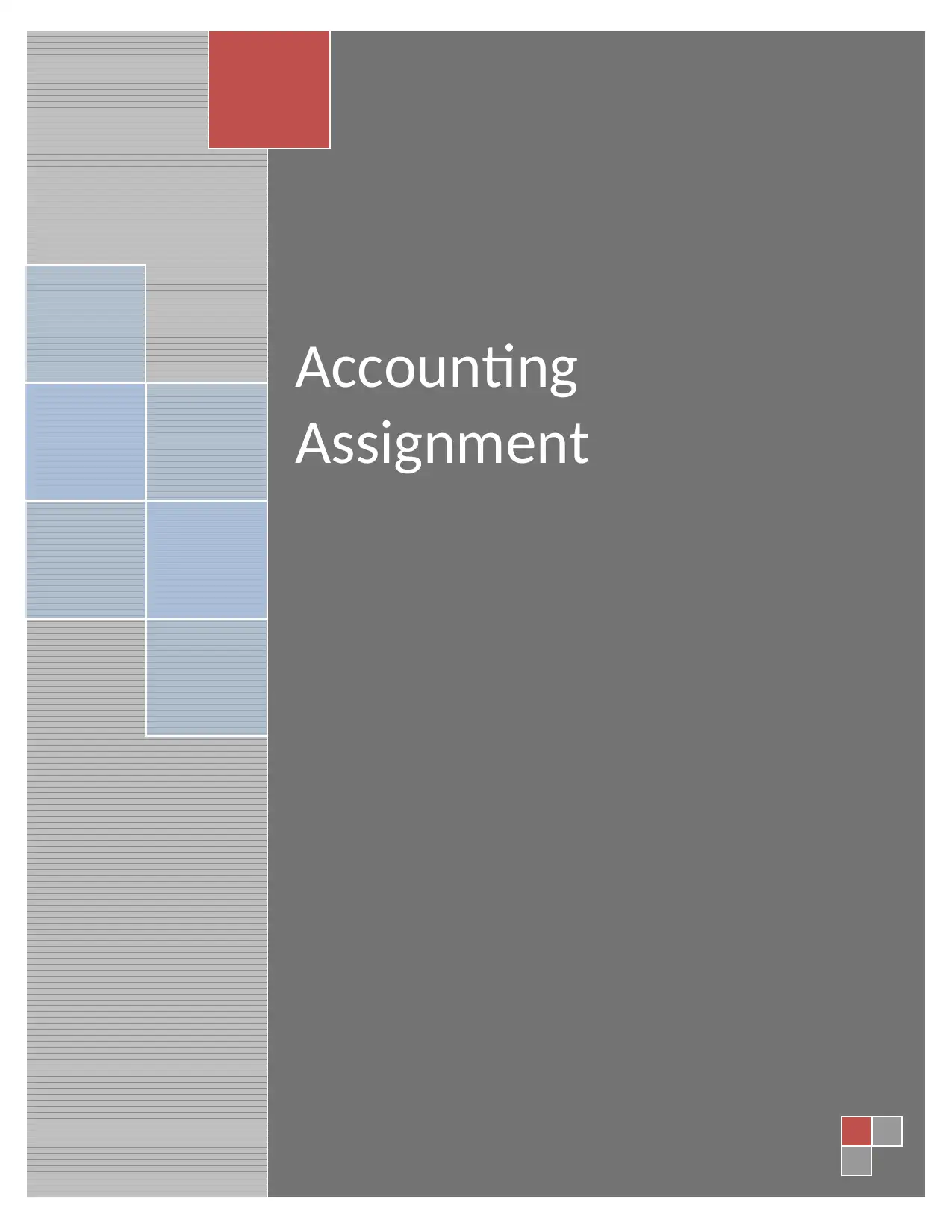
Accounting
Assignment
Assignment
Paraphrase This Document
Need a fresh take? Get an instant paraphrase of this document with our AI Paraphraser
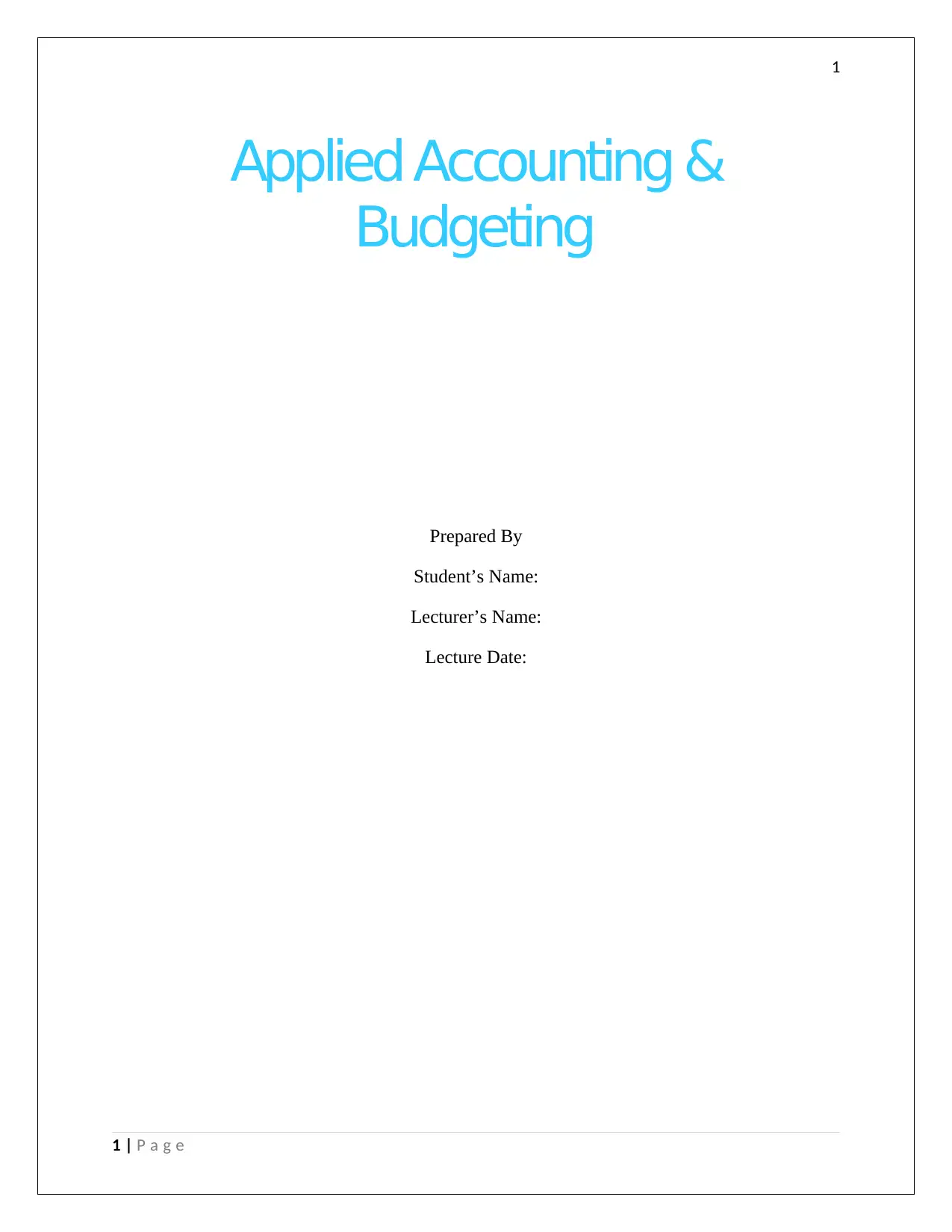
1
Prepared By
Student’s Name:
Lecturer’s Name:
Lecture Date:
1 | P a g e
Applied Accounting &
Budgeting
Prepared By
Student’s Name:
Lecturer’s Name:
Lecture Date:
1 | P a g e
Applied Accounting &
Budgeting
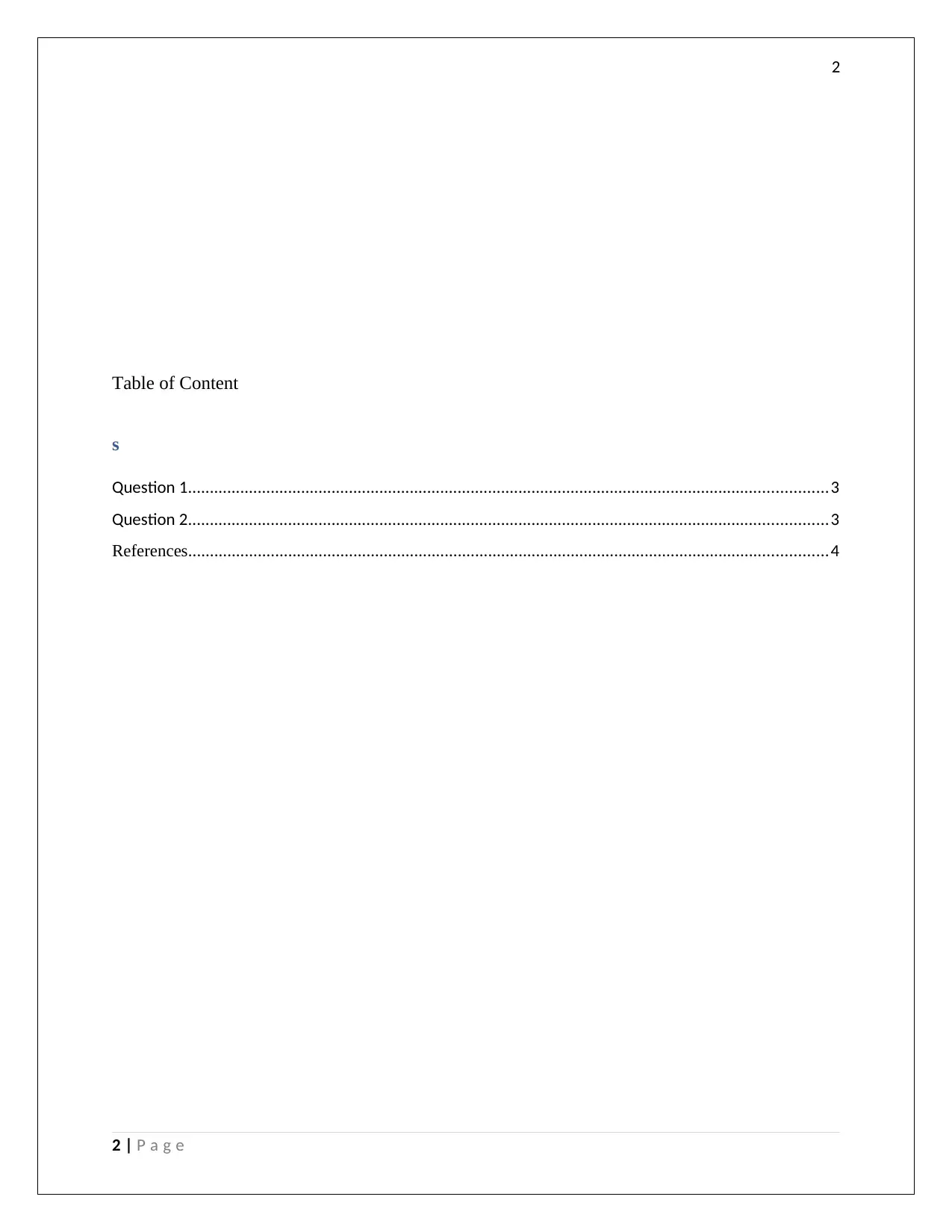
2
Table of Content
s
Question 1...................................................................................................................................................3
Question 2...................................................................................................................................................3
References...................................................................................................................................................4
2 | P a g e
Table of Content
s
Question 1...................................................................................................................................................3
Question 2...................................................................................................................................................3
References...................................................................................................................................................4
2 | P a g e
⊘ This is a preview!⊘
Do you want full access?
Subscribe today to unlock all pages.

Trusted by 1+ million students worldwide
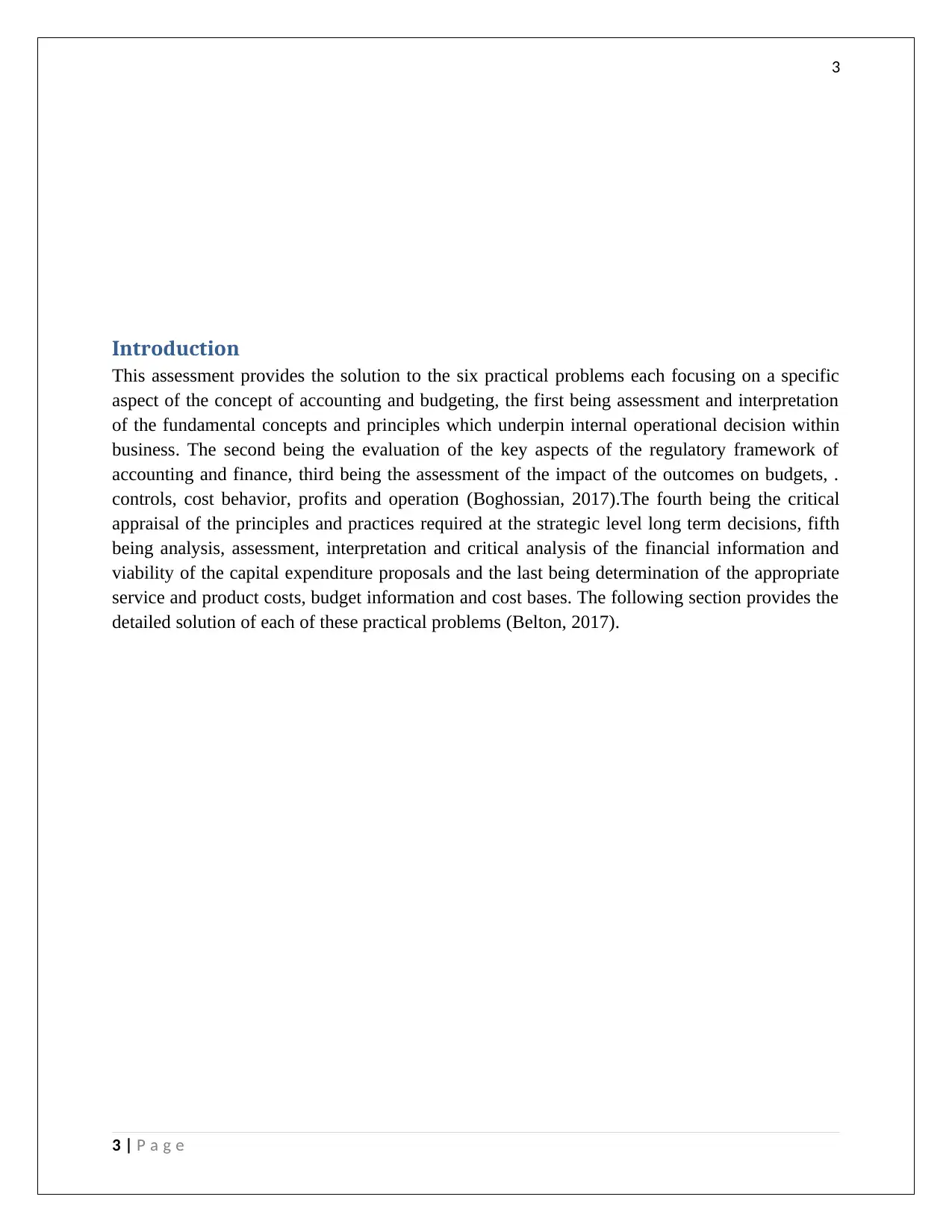
3
Introduction
This assessment provides the solution to the six practical problems each focusing on a specific
aspect of the concept of accounting and budgeting, the first being assessment and interpretation
of the fundamental concepts and principles which underpin internal operational decision within
business. The second being the evaluation of the key aspects of the regulatory framework of
accounting and finance, third being the assessment of the impact of the outcomes on budgets, .
controls, cost behavior, profits and operation (Boghossian, 2017).The fourth being the critical
appraisal of the principles and practices required at the strategic level long term decisions, fifth
being analysis, assessment, interpretation and critical analysis of the financial information and
viability of the capital expenditure proposals and the last being determination of the appropriate
service and product costs, budget information and cost bases. The following section provides the
detailed solution of each of these practical problems (Belton, 2017).
3 | P a g e
Introduction
This assessment provides the solution to the six practical problems each focusing on a specific
aspect of the concept of accounting and budgeting, the first being assessment and interpretation
of the fundamental concepts and principles which underpin internal operational decision within
business. The second being the evaluation of the key aspects of the regulatory framework of
accounting and finance, third being the assessment of the impact of the outcomes on budgets, .
controls, cost behavior, profits and operation (Boghossian, 2017).The fourth being the critical
appraisal of the principles and practices required at the strategic level long term decisions, fifth
being analysis, assessment, interpretation and critical analysis of the financial information and
viability of the capital expenditure proposals and the last being determination of the appropriate
service and product costs, budget information and cost bases. The following section provides the
detailed solution of each of these practical problems (Belton, 2017).
3 | P a g e
Paraphrase This Document
Need a fresh take? Get an instant paraphrase of this document with our AI Paraphraser
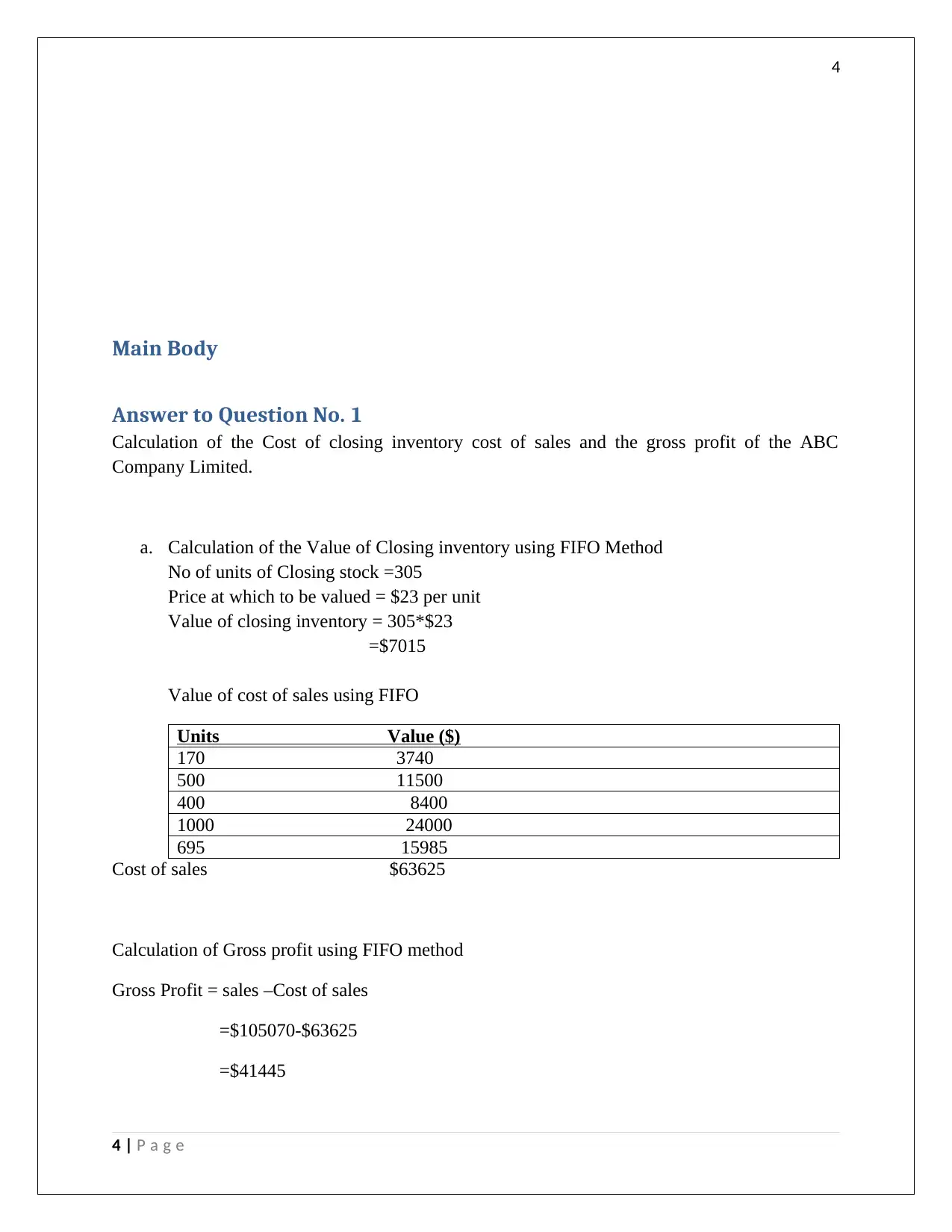
4
Main Body
Answer to Question No. 1
Calculation of the Cost of closing inventory cost of sales and the gross profit of the ABC
Company Limited.
a. Calculation of the Value of Closing inventory using FIFO Method
No of units of Closing stock =305
Price at which to be valued = $23 per unit
Value of closing inventory = 305*$23
=$7015
Value of cost of sales using FIFO
Units Value ($)
170 3740
500 11500
400 8400
1000 24000
695 15985
Cost of sales $63625
Calculation of Gross profit using FIFO method
Gross Profit = sales –Cost of sales
=$105070-$63625
=$41445
4 | P a g e
Main Body
Answer to Question No. 1
Calculation of the Cost of closing inventory cost of sales and the gross profit of the ABC
Company Limited.
a. Calculation of the Value of Closing inventory using FIFO Method
No of units of Closing stock =305
Price at which to be valued = $23 per unit
Value of closing inventory = 305*$23
=$7015
Value of cost of sales using FIFO
Units Value ($)
170 3740
500 11500
400 8400
1000 24000
695 15985
Cost of sales $63625
Calculation of Gross profit using FIFO method
Gross Profit = sales –Cost of sales
=$105070-$63625
=$41445
4 | P a g e
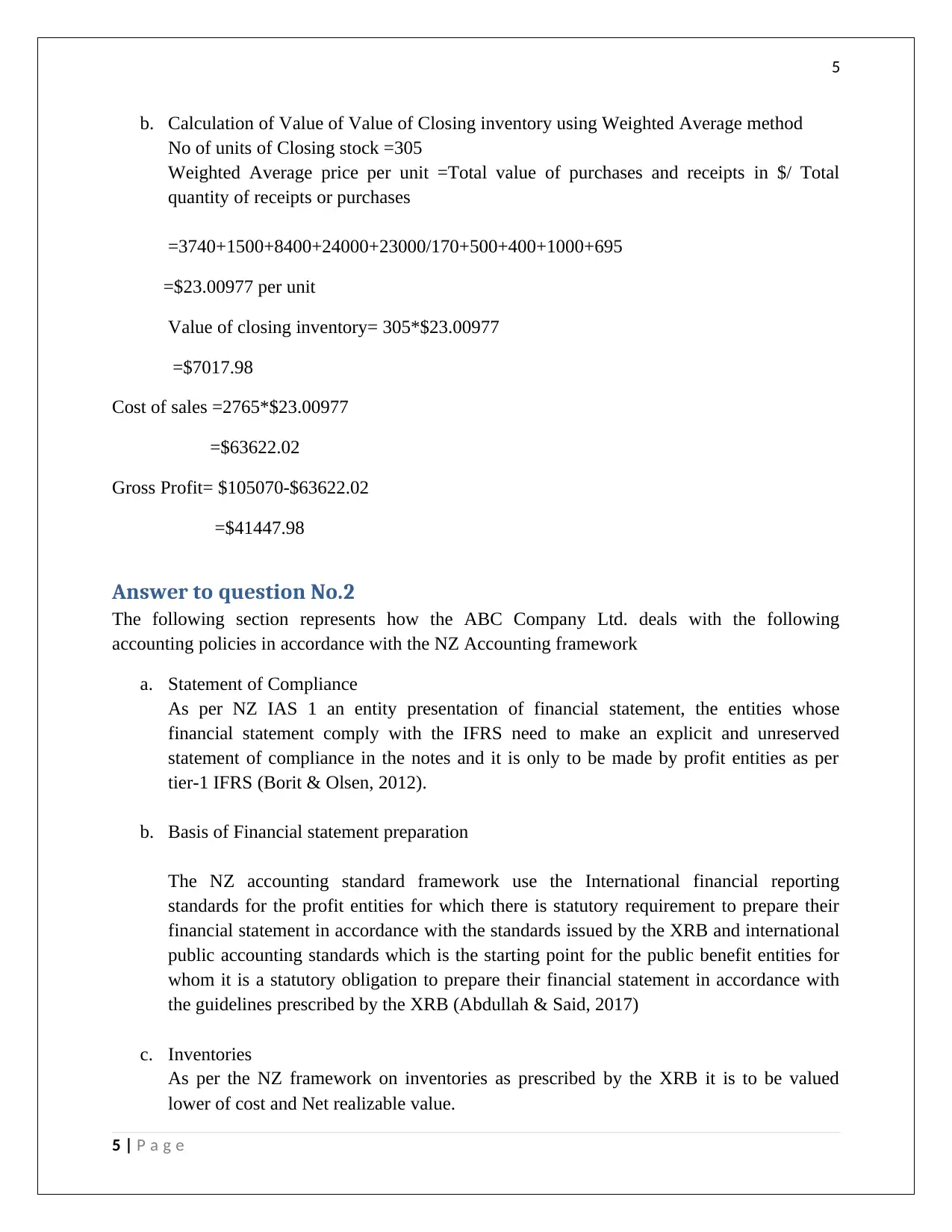
5
b. Calculation of Value of Value of Closing inventory using Weighted Average method
No of units of Closing stock =305
Weighted Average price per unit =Total value of purchases and receipts in $/ Total
quantity of receipts or purchases
=3740+1500+8400+24000+23000/170+500+400+1000+695
=$23.00977 per unit
Value of closing inventory= 305*$23.00977
=$7017.98
Cost of sales =2765*$23.00977
=$63622.02
Gross Profit= $105070-$63622.02
=$41447.98
Answer to question No.2
The following section represents how the ABC Company Ltd. deals with the following
accounting policies in accordance with the NZ Accounting framework
a. Statement of Compliance
As per NZ IAS 1 an entity presentation of financial statement, the entities whose
financial statement comply with the IFRS need to make an explicit and unreserved
statement of compliance in the notes and it is only to be made by profit entities as per
tier-1 IFRS (Borit & Olsen, 2012).
b. Basis of Financial statement preparation
The NZ accounting standard framework use the International financial reporting
standards for the profit entities for which there is statutory requirement to prepare their
financial statement in accordance with the standards issued by the XRB and international
public accounting standards which is the starting point for the public benefit entities for
whom it is a statutory obligation to prepare their financial statement in accordance with
the guidelines prescribed by the XRB (Abdullah & Said, 2017)
c. Inventories
As per the NZ framework on inventories as prescribed by the XRB it is to be valued
lower of cost and Net realizable value.
5 | P a g e
b. Calculation of Value of Value of Closing inventory using Weighted Average method
No of units of Closing stock =305
Weighted Average price per unit =Total value of purchases and receipts in $/ Total
quantity of receipts or purchases
=3740+1500+8400+24000+23000/170+500+400+1000+695
=$23.00977 per unit
Value of closing inventory= 305*$23.00977
=$7017.98
Cost of sales =2765*$23.00977
=$63622.02
Gross Profit= $105070-$63622.02
=$41447.98
Answer to question No.2
The following section represents how the ABC Company Ltd. deals with the following
accounting policies in accordance with the NZ Accounting framework
a. Statement of Compliance
As per NZ IAS 1 an entity presentation of financial statement, the entities whose
financial statement comply with the IFRS need to make an explicit and unreserved
statement of compliance in the notes and it is only to be made by profit entities as per
tier-1 IFRS (Borit & Olsen, 2012).
b. Basis of Financial statement preparation
The NZ accounting standard framework use the International financial reporting
standards for the profit entities for which there is statutory requirement to prepare their
financial statement in accordance with the standards issued by the XRB and international
public accounting standards which is the starting point for the public benefit entities for
whom it is a statutory obligation to prepare their financial statement in accordance with
the guidelines prescribed by the XRB (Abdullah & Said, 2017)
c. Inventories
As per the NZ framework on inventories as prescribed by the XRB it is to be valued
lower of cost and Net realizable value.
5 | P a g e
⊘ This is a preview!⊘
Do you want full access?
Subscribe today to unlock all pages.

Trusted by 1+ million students worldwide
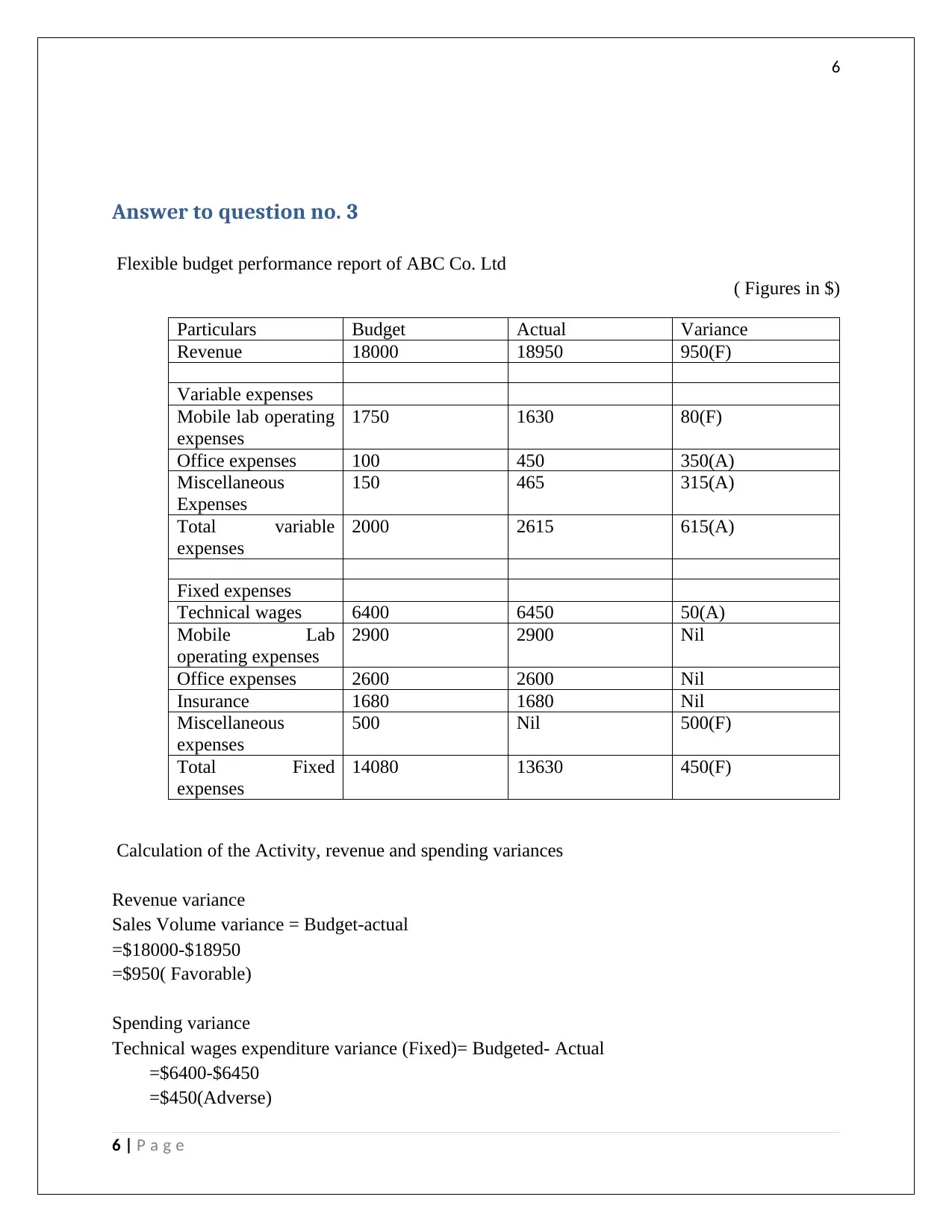
6
Answer to question no. 3
Flexible budget performance report of ABC Co. Ltd
( Figures in $)
Particulars Budget Actual Variance
Revenue 18000 18950 950(F)
Variable expenses
Mobile lab operating
expenses
1750 1630 80(F)
Office expenses 100 450 350(A)
Miscellaneous
Expenses
150 465 315(A)
Total variable
expenses
2000 2615 615(A)
Fixed expenses
Technical wages 6400 6450 50(A)
Mobile Lab
operating expenses
2900 2900 Nil
Office expenses 2600 2600 Nil
Insurance 1680 1680 Nil
Miscellaneous
expenses
500 Nil 500(F)
Total Fixed
expenses
14080 13630 450(F)
Calculation of the Activity, revenue and spending variances
Revenue variance
Sales Volume variance = Budget-actual
=$18000-$18950
=$950( Favorable)
Spending variance
Technical wages expenditure variance (Fixed)= Budgeted- Actual
=$6400-$6450
=$450(Adverse)
6 | P a g e
Answer to question no. 3
Flexible budget performance report of ABC Co. Ltd
( Figures in $)
Particulars Budget Actual Variance
Revenue 18000 18950 950(F)
Variable expenses
Mobile lab operating
expenses
1750 1630 80(F)
Office expenses 100 450 350(A)
Miscellaneous
Expenses
150 465 315(A)
Total variable
expenses
2000 2615 615(A)
Fixed expenses
Technical wages 6400 6450 50(A)
Mobile Lab
operating expenses
2900 2900 Nil
Office expenses 2600 2600 Nil
Insurance 1680 1680 Nil
Miscellaneous
expenses
500 Nil 500(F)
Total Fixed
expenses
14080 13630 450(F)
Calculation of the Activity, revenue and spending variances
Revenue variance
Sales Volume variance = Budget-actual
=$18000-$18950
=$950( Favorable)
Spending variance
Technical wages expenditure variance (Fixed)= Budgeted- Actual
=$6400-$6450
=$450(Adverse)
6 | P a g e
Paraphrase This Document
Need a fresh take? Get an instant paraphrase of this document with our AI Paraphraser
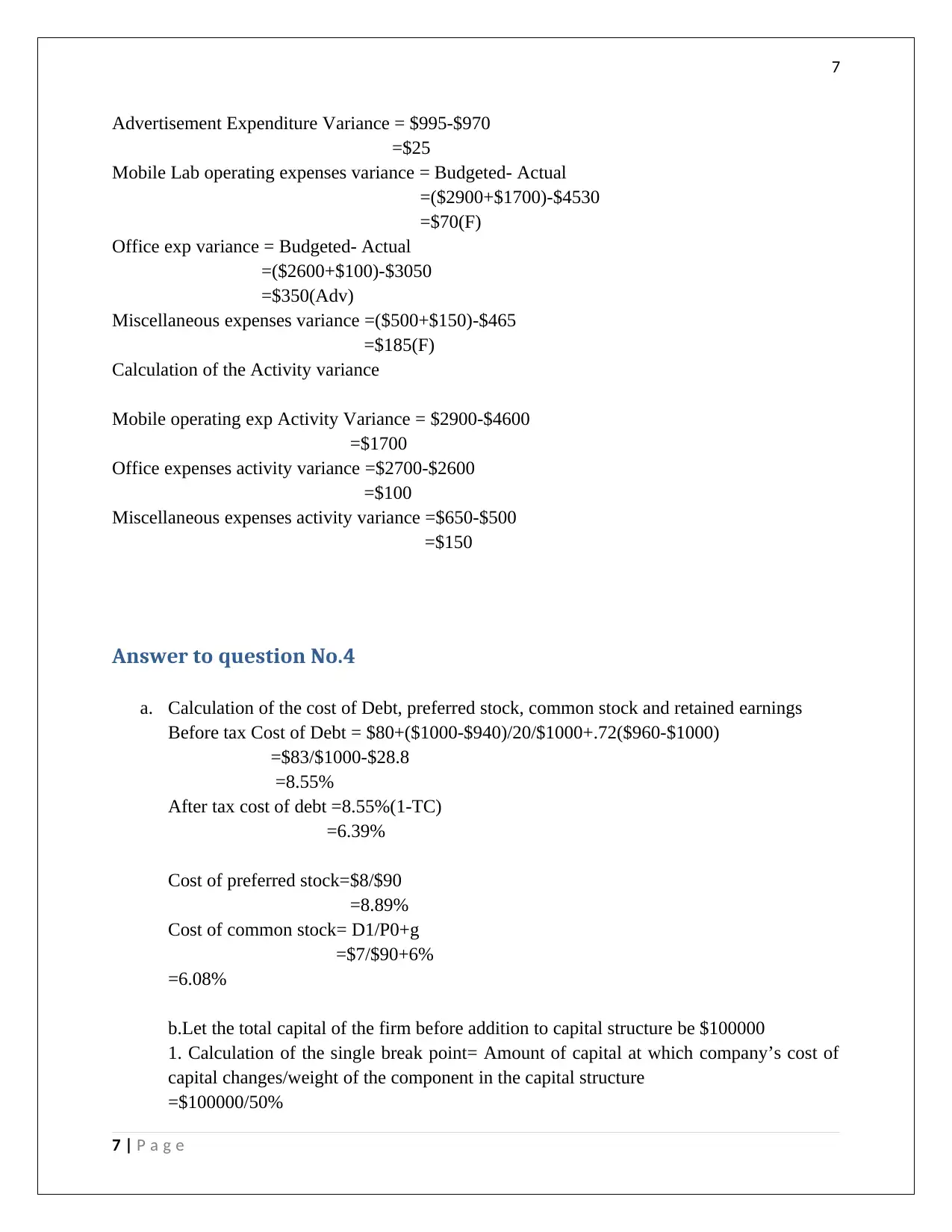
7
Advertisement Expenditure Variance = $995-$970
=$25
Mobile Lab operating expenses variance = Budgeted- Actual
=($2900+$1700)-$4530
=$70(F)
Office exp variance = Budgeted- Actual
=($2600+$100)-$3050
=$350(Adv)
Miscellaneous expenses variance =($500+$150)-$465
=$185(F)
Calculation of the Activity variance
Mobile operating exp Activity Variance = $2900-$4600
=$1700
Office expenses activity variance =$2700-$2600
=$100
Miscellaneous expenses activity variance =$650-$500
=$150
Answer to question No.4
a. Calculation of the cost of Debt, preferred stock, common stock and retained earnings
Before tax Cost of Debt = $80+($1000-$940)/20/$1000+.72($960-$1000)
=$83/$1000-$28.8
=8.55%
After tax cost of debt =8.55%(1-TC)
=6.39%
Cost of preferred stock=$8/$90
=8.89%
Cost of common stock= D1/P0+g
=$7/$90+6%
=6.08%
b.Let the total capital of the firm before addition to capital structure be $100000
1. Calculation of the single break point= Amount of capital at which company’s cost of
capital changes/weight of the component in the capital structure
=$100000/50%
7 | P a g e
Advertisement Expenditure Variance = $995-$970
=$25
Mobile Lab operating expenses variance = Budgeted- Actual
=($2900+$1700)-$4530
=$70(F)
Office exp variance = Budgeted- Actual
=($2600+$100)-$3050
=$350(Adv)
Miscellaneous expenses variance =($500+$150)-$465
=$185(F)
Calculation of the Activity variance
Mobile operating exp Activity Variance = $2900-$4600
=$1700
Office expenses activity variance =$2700-$2600
=$100
Miscellaneous expenses activity variance =$650-$500
=$150
Answer to question No.4
a. Calculation of the cost of Debt, preferred stock, common stock and retained earnings
Before tax Cost of Debt = $80+($1000-$940)/20/$1000+.72($960-$1000)
=$83/$1000-$28.8
=8.55%
After tax cost of debt =8.55%(1-TC)
=6.39%
Cost of preferred stock=$8/$90
=8.89%
Cost of common stock= D1/P0+g
=$7/$90+6%
=6.08%
b.Let the total capital of the firm before addition to capital structure be $100000
1. Calculation of the single break point= Amount of capital at which company’s cost of
capital changes/weight of the component in the capital structure
=$100000/50%
7 | P a g e
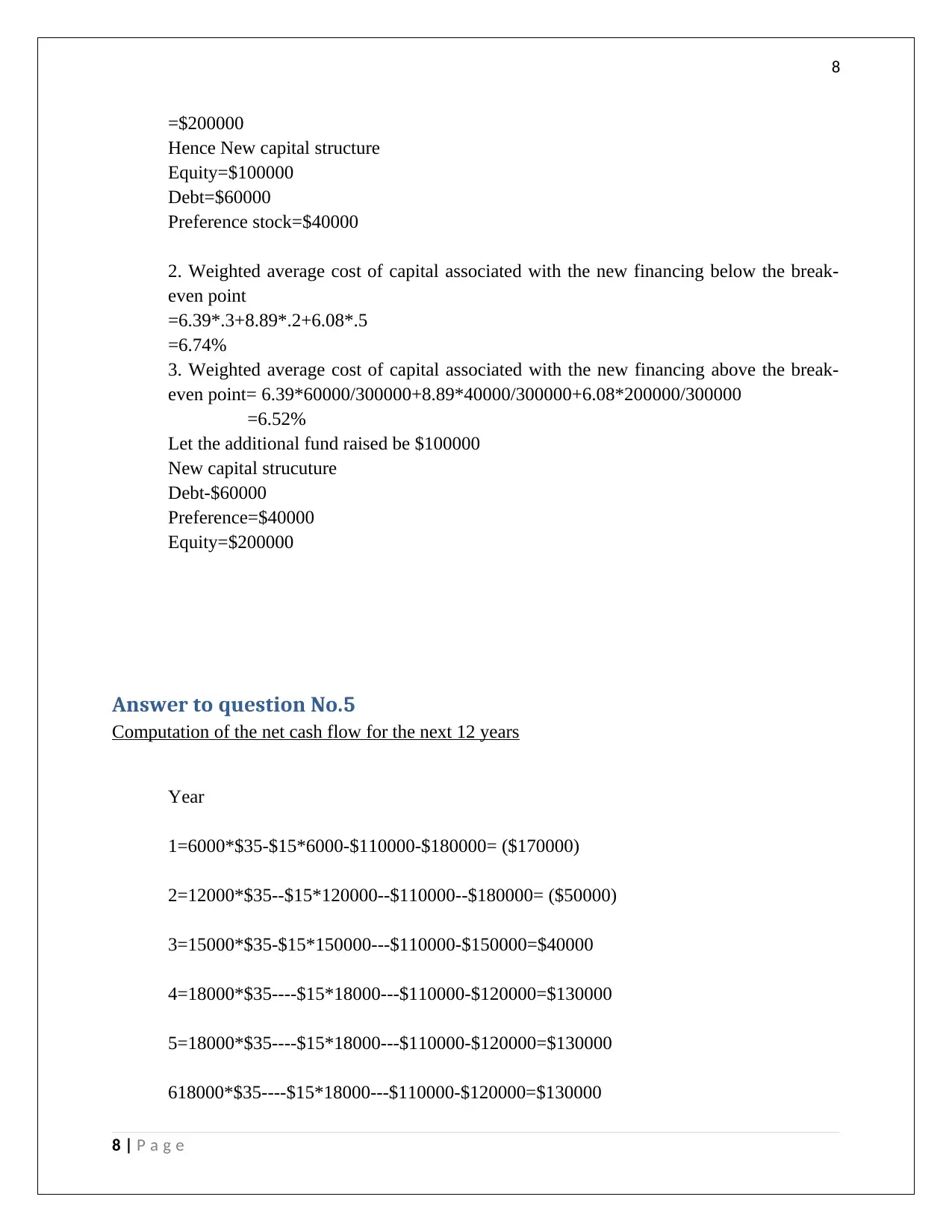
8
=$200000
Hence New capital structure
Equity=$100000
Debt=$60000
Preference stock=$40000
2. Weighted average cost of capital associated with the new financing below the break-
even point
=6.39*.3+8.89*.2+6.08*.5
=6.74%
3. Weighted average cost of capital associated with the new financing above the break-
even point= 6.39*60000/300000+8.89*40000/300000+6.08*200000/300000
=6.52%
Let the additional fund raised be $100000
New capital strucuture
Debt-$60000
Preference=$40000
Equity=$200000
Answer to question No.5
Computation of the net cash flow for the next 12 years
Year
1=6000*$35-$15*6000-$110000-$180000= ($170000)
2=12000*$35--$15*120000--$110000--$180000= ($50000)
3=15000*$35-$15*150000---$110000-$150000=$40000
4=18000*$35----$15*18000---$110000-$120000=$130000
5=18000*$35----$15*18000---$110000-$120000=$130000
618000*$35----$15*18000---$110000-$120000=$130000
8 | P a g e
=$200000
Hence New capital structure
Equity=$100000
Debt=$60000
Preference stock=$40000
2. Weighted average cost of capital associated with the new financing below the break-
even point
=6.39*.3+8.89*.2+6.08*.5
=6.74%
3. Weighted average cost of capital associated with the new financing above the break-
even point= 6.39*60000/300000+8.89*40000/300000+6.08*200000/300000
=6.52%
Let the additional fund raised be $100000
New capital strucuture
Debt-$60000
Preference=$40000
Equity=$200000
Answer to question No.5
Computation of the net cash flow for the next 12 years
Year
1=6000*$35-$15*6000-$110000-$180000= ($170000)
2=12000*$35--$15*120000--$110000--$180000= ($50000)
3=15000*$35-$15*150000---$110000-$150000=$40000
4=18000*$35----$15*18000---$110000-$120000=$130000
5=18000*$35----$15*18000---$110000-$120000=$130000
618000*$35----$15*18000---$110000-$120000=$130000
8 | P a g e
⊘ This is a preview!⊘
Do you want full access?
Subscribe today to unlock all pages.

Trusted by 1+ million students worldwide
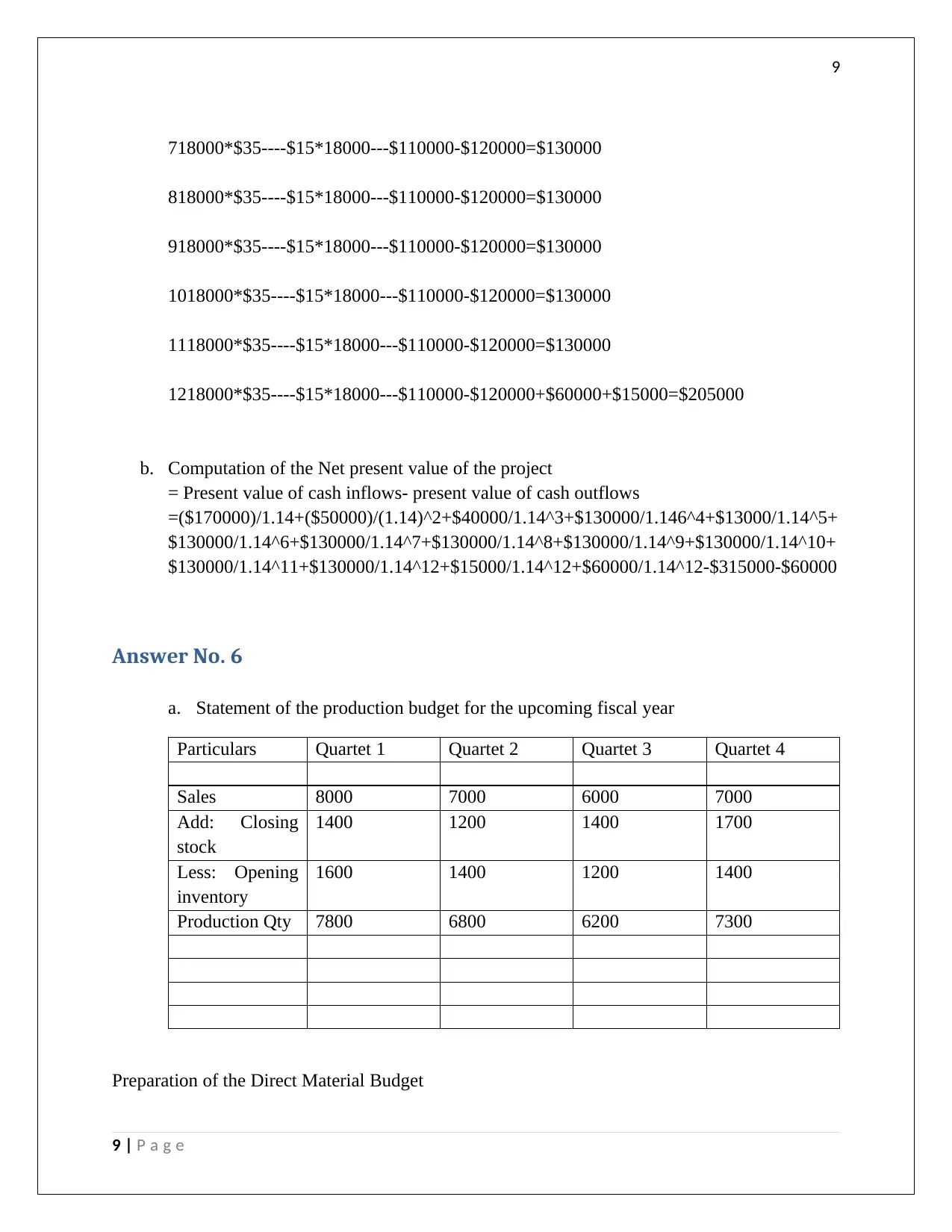
9
718000*$35----$15*18000---$110000-$120000=$130000
818000*$35----$15*18000---$110000-$120000=$130000
918000*$35----$15*18000---$110000-$120000=$130000
1018000*$35----$15*18000---$110000-$120000=$130000
1118000*$35----$15*18000---$110000-$120000=$130000
1218000*$35----$15*18000---$110000-$120000+$60000+$15000=$205000
b. Computation of the Net present value of the project
= Present value of cash inflows- present value of cash outflows
=($170000)/1.14+($50000)/(1.14)^2+$40000/1.14^3+$130000/1.146^4+$13000/1.14^5+
$130000/1.14^6+$130000/1.14^7+$130000/1.14^8+$130000/1.14^9+$130000/1.14^10+
$130000/1.14^11+$130000/1.14^12+$15000/1.14^12+$60000/1.14^12-$315000-$60000
Answer No. 6
a. Statement of the production budget for the upcoming fiscal year
Particulars Quartet 1 Quartet 2 Quartet 3 Quartet 4
Sales 8000 7000 6000 7000
Add: Closing
stock
1400 1200 1400 1700
Less: Opening
inventory
1600 1400 1200 1400
Production Qty 7800 6800 6200 7300
Preparation of the Direct Material Budget
9 | P a g e
718000*$35----$15*18000---$110000-$120000=$130000
818000*$35----$15*18000---$110000-$120000=$130000
918000*$35----$15*18000---$110000-$120000=$130000
1018000*$35----$15*18000---$110000-$120000=$130000
1118000*$35----$15*18000---$110000-$120000=$130000
1218000*$35----$15*18000---$110000-$120000+$60000+$15000=$205000
b. Computation of the Net present value of the project
= Present value of cash inflows- present value of cash outflows
=($170000)/1.14+($50000)/(1.14)^2+$40000/1.14^3+$130000/1.146^4+$13000/1.14^5+
$130000/1.14^6+$130000/1.14^7+$130000/1.14^8+$130000/1.14^9+$130000/1.14^10+
$130000/1.14^11+$130000/1.14^12+$15000/1.14^12+$60000/1.14^12-$315000-$60000
Answer No. 6
a. Statement of the production budget for the upcoming fiscal year
Particulars Quartet 1 Quartet 2 Quartet 3 Quartet 4
Sales 8000 7000 6000 7000
Add: Closing
stock
1400 1200 1400 1700
Less: Opening
inventory
1600 1400 1200 1400
Production Qty 7800 6800 6200 7300
Preparation of the Direct Material Budget
9 | P a g e
Paraphrase This Document
Need a fresh take? Get an instant paraphrase of this document with our AI Paraphraser
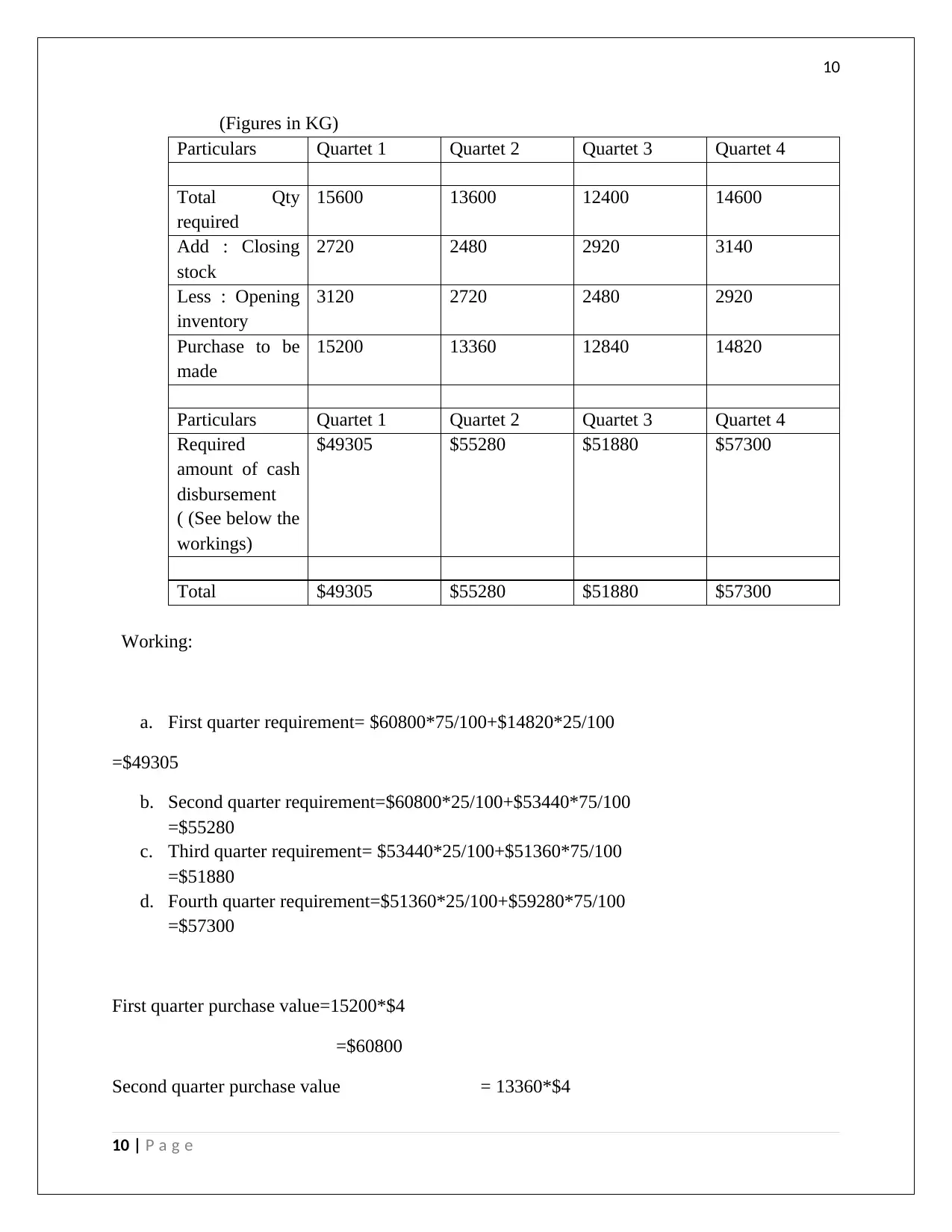
10
(Figures in KG)
Particulars Quartet 1 Quartet 2 Quartet 3 Quartet 4
Total Qty
required
15600 13600 12400 14600
Add : Closing
stock
2720 2480 2920 3140
Less : Opening
inventory
3120 2720 2480 2920
Purchase to be
made
15200 13360 12840 14820
Particulars Quartet 1 Quartet 2 Quartet 3 Quartet 4
Required
amount of cash
disbursement
( (See below the
workings)
$49305 $55280 $51880 $57300
Total $49305 $55280 $51880 $57300
Working:
a. First quarter requirement= $60800*75/100+$14820*25/100
=$49305
b. Second quarter requirement=$60800*25/100+$53440*75/100
=$55280
c. Third quarter requirement= $53440*25/100+$51360*75/100
=$51880
d. Fourth quarter requirement=$51360*25/100+$59280*75/100
=$57300
First quarter purchase value=15200*$4
=$60800
Second quarter purchase value = 13360*$4
10 | P a g e
(Figures in KG)
Particulars Quartet 1 Quartet 2 Quartet 3 Quartet 4
Total Qty
required
15600 13600 12400 14600
Add : Closing
stock
2720 2480 2920 3140
Less : Opening
inventory
3120 2720 2480 2920
Purchase to be
made
15200 13360 12840 14820
Particulars Quartet 1 Quartet 2 Quartet 3 Quartet 4
Required
amount of cash
disbursement
( (See below the
workings)
$49305 $55280 $51880 $57300
Total $49305 $55280 $51880 $57300
Working:
a. First quarter requirement= $60800*75/100+$14820*25/100
=$49305
b. Second quarter requirement=$60800*25/100+$53440*75/100
=$55280
c. Third quarter requirement= $53440*25/100+$51360*75/100
=$51880
d. Fourth quarter requirement=$51360*25/100+$59280*75/100
=$57300
First quarter purchase value=15200*$4
=$60800
Second quarter purchase value = 13360*$4
10 | P a g e
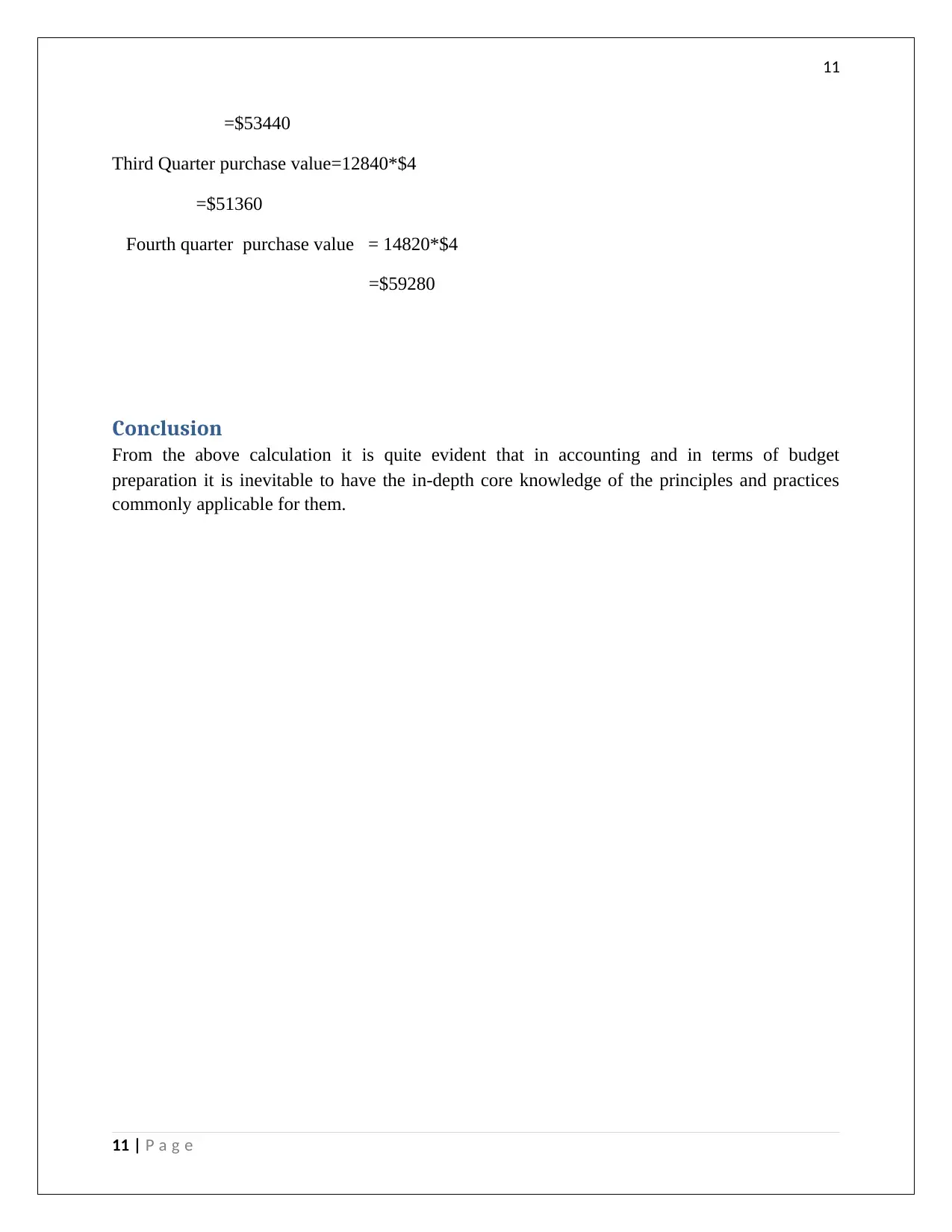
11
=$53440
Third Quarter purchase value=12840*$4
=$51360
Fourth quarter purchase value = 14820*$4
=$59280
Conclusion
From the above calculation it is quite evident that in accounting and in terms of budget
preparation it is inevitable to have the in-depth core knowledge of the principles and practices
commonly applicable for them.
11 | P a g e
=$53440
Third Quarter purchase value=12840*$4
=$51360
Fourth quarter purchase value = 14820*$4
=$59280
Conclusion
From the above calculation it is quite evident that in accounting and in terms of budget
preparation it is inevitable to have the in-depth core knowledge of the principles and practices
commonly applicable for them.
11 | P a g e
⊘ This is a preview!⊘
Do you want full access?
Subscribe today to unlock all pages.

Trusted by 1+ million students worldwide
1 out of 13
Related Documents
Your All-in-One AI-Powered Toolkit for Academic Success.
+13062052269
info@desklib.com
Available 24*7 on WhatsApp / Email
![[object Object]](/_next/static/media/star-bottom.7253800d.svg)
Unlock your academic potential
Copyright © 2020–2025 A2Z Services. All Rights Reserved. Developed and managed by ZUCOL.





